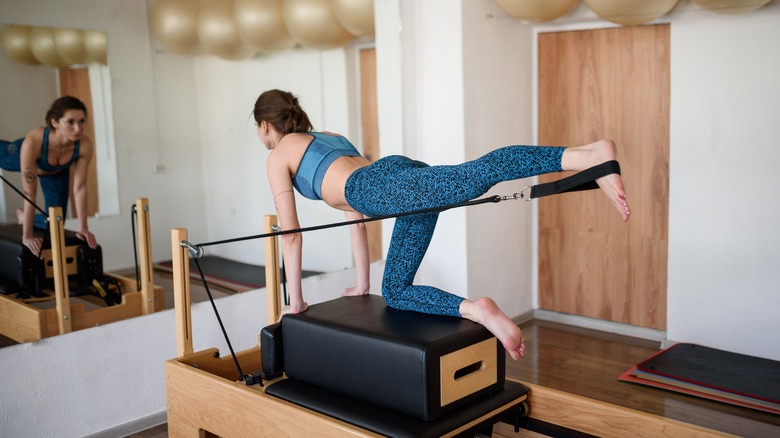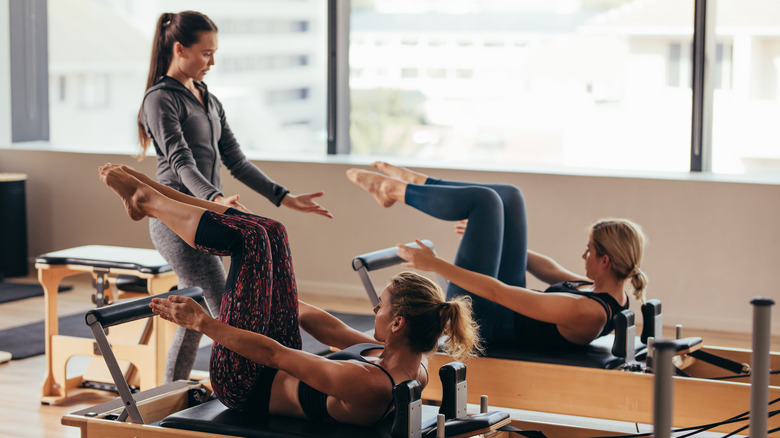Why You Should Consider Doing Pilates If You Have MS
Diagnosis of a new illness can bring about a number of lifestyle changes. The introduction of new medication regimens, repeated follow-up appointments, and diet changes are just a few areas that can be impacted by receiving the news that you've developed an illness. Diagnosis can also mean changing your physical activities and imposing limitations on what you can and cannot accomplish. One such illness is a disabling disease known as multiple sclerosis (MS).
The National Multiple Sclerosis Society explains that MS is a disease that affects the central nervous system, specifically the brain, spinal cord, and optic nerves. As the disease progresses, damage to the central nervous system occurs as a result of the body's immune system attacking the protective myelin which covers the nerve fibers (via Mayo Clinic). The nerve damage causes an interference in the communication between the nerves and brain causing a number of symptoms including a tingling sensation, numbness, paralysis, and pain. MS can also cause problems in mood and memory (via National Multiple Sclerosis Society).
There is no specific known cause for MS and the symptoms experienced can vary from person to person, including the longevity of the effect. Treatment options can also vary, depending on the individual, and for many MS patients, regular exercise is recommended to help manage symptoms (via National Multiple Sclerosis Society). But what kind of exercise is good for MS?
Overview of Pilates
An important component of any exercise routine is one that offers consistent challenges and opportunities for becoming stronger or having more stamina. Pilates, a popular form of fitness activity, is a form of resistance training using body weight, mats, and specialized equipment to move through a series of specifically designed movements (via Healthline). While there's conflicting information regarding the number of exercises that exist in Pilates, Medicine Net explains that the current form of Pilates was coined by Joseph Pilates in the 1920s. He worked as a physical trainer to help soldiers returning from war as well as dancers to heal their bodies and regain their strength.
The exercises are designed to help improve flexibility, bodily control, and strength with a focus on improving and strengthening the core muscle groups (via Healthline). The focus on core strength helps to create stabilization while moving through other routine body movements. Pilates exercises can appear misleading, with seemingly simple moves that are repeated at a manageable pace and practice. However, the activation and use of these deeper muscle groups required for stabilization create a more impactful workout without requiring hours of cardio or heavy, intense, weight lifting. Most average Pilates workouts last around 45 minutes according to WebMD.
How can Pilates help MS?
MS can be a very debilitating disease that for some, results in the need for assistive mobility devices like canes, walkers, or even wheelchairs, according to the MS Society. Like many illnesses, regular physical activity, specifically aerobic exercise, has shown to be a positive impact on many of the symptoms associated with MS, says the National Multiple Sclerosis Society. In addition to the traditional benefits of regular exercise, like improved cardiovascular performance and strength, for individuals with MS, such a routine can also provide improvements in mood, cognitive function, and even bladder control. They also recommend activities that focus on improving balance and flexibility. People with MS can reap the benefits of adding Pilates to a daily exercise routine. Moreover, the adaptability and variety of levels from low impact to more intense offer individuals with MS a great option for continued improvements.
If you're struggling with body coordination as a result of a multiple sclerosis diagnosis, you may want to explore Pilates as a holistic means of improving your flexibility and providing relief from some of your symptoms. As always, you should consult with your doctor or physician prior to engaging in any new exercise routine.


